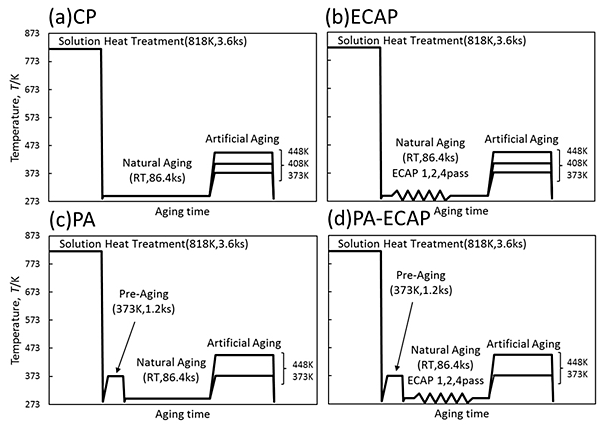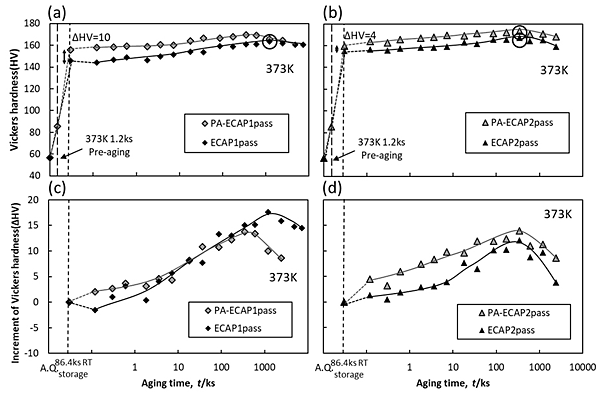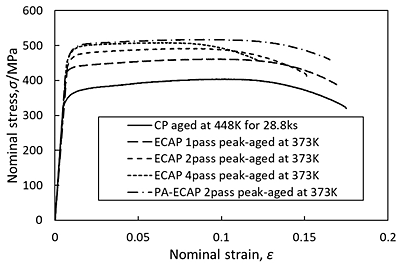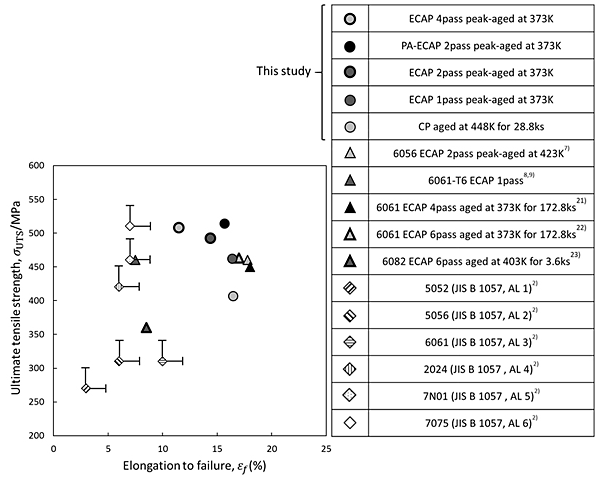The application of aluminum-made bolts can not only reduce the weight of automobiles but also solve galvanic corrosion problem caused by the difference of standard electrode potentials between aluminum and steel. However, ultimate tensile strength (UTS) of conventional corrosion-resistant and formable Al-Mg-Si alloy bolts is about 320MPa, and thus the range of application is quite limited, resulting in plastic region tightening disallowing the reuse of bolts. Therefore, if further strengthening can be achieved, elastic region tightening becomes possible, enabling not only to reuse the bolts but also to simplify working procedure of fastening. The purpose of this study is to increase the mechanical strength of an A6056 Al-Mg-Si alloy, without diminishing the elongation, for developing a high-strength bolt material through grain refinement strengthening by Equal-Channel Angular Pressing (ECAP) and precipitation strengthening by various aging treatments including Pre-aging (PA).
The conventional manufacturing process of aluminum-made bolts consists of cold forging (screw head forming), solid solution treatment, water quenching (WQ), natural aging (RT storage), artificial aging and thread rolling. In this study, however, the specimens subject to processes excluding forging and thread rolling were referred to as the conventionally processed (CP) specimen. The schematic representation of the thermomechanical procedure of the CP specimen is shown in Fig. 1(a), in which commercially adopted conditions of natural and artificial aging are depicted as at RT for 86.4ks and at 448K for 28.8ks, respectively. The ECAP, PA and PA-ECAP specimens were fabricated by 1, 2 or 4passes of ECAP within 7.2ks after WQ (Fig. 1(b)), by pre-aging at 373K for 1.2ks immediately after WQ (Fig. 1(c)) and by combined application of PA and ECAP (Fig. 1(d)), followed by artificial aging at 373, 408 or 448K. It can be considered that there is no influence of timing of ECAP on mechanical properties of the ECAP and PA-ECAP specimens because the hardness of the two specimens does not change until 7.2ks of RT storage after WQ, and until 24h of RT storage after ECAP.
Figures 2(a,b) shows the changes in hardness during artificial aging at 373K for the ECAP 1, 2pass and PA-ECAP 1, 2pass specimens. By the application of pre-aging before ECAP, the hardness of the PA-ECAP specimen became higher than that of the ECAP specimen, but the increment in hardness was monotonously decreased from ΔHV10 (ECAP 1pass) to ΔHV4 (ECAP 2pass) or ΔHV2 (ECAP 4pass, but no data is shown in the paper). This decrease of increment in hardness is probably because nanoclusters formed during pre-aging were decomposed and re-dissolved into the matrix by accumulative dislocations introduced by the subsequent ECAP, resulting in the gradual decrease in contribution of nanoclusters with increasing the number of ECAP passes. Note that the difference in hardness between WQ and PA specimens (i.e. ΔHV29) is due to the formation of nanoclusters, and thus if the amount of nanoclusters is decreased by ECAP, the increase in hardness from ECAP specimens must have been decreased to ΔHV10, ΔHV4, ΔHV2 and so on.
On the other hand, the age-hardenability of the PA-ECAP 1pass specimen (ΔHV14) was lower than that of the ECAP 1pass specimen (ΔHV18) as illustrated in Fig. 2(c). This suggests that the amount of precipitates formed during artificial aging is smaller than that of the ECAP 1pass specimen because a part of nanoclusters formed during pre-aging survive even after ECAP 1pass, resulting in the suppressed age-hardenability during artificial aging of the PA-ECAP 1pass specimen. However, the age-hardenability of the PA-ECAP 2pass specimen (ΔHV14) was higher than that of ECAP 2pass specimen (ΔHV12) as illustrated in Fig. 2(d). This reverse phenomenon may be because most of nanoclusters formed during pre-aging are decomposed and re-dissolved into the matrix by ECAP 2pass, and thus a larger amount of precipitates can be formed during artificial aging, responsible for the larger increment in hardness of the PA-ECAP 2pass specimen.
Figure 3 shows the results of tensile test for the developed bolt material. The estimated UTS of the ECAP 1, 2 and 4pass specimens; i.e. 462, 492 and 509MPa, was higher than that of the CP specimen (405MPa), but the elongation to failure was monotonically decreased from 17% of the CP specimen to 12% of the ECAP 4pass specimen. However, UTS and elongation to failure of the PA-ECAP 2pass specimen were 514MPa and 16%, suggesting that combined application of pre-aging and ECAP 2pass can achieve not only a high strength comparable to that of the ECAP 4pass specimen, but also sufficient ductility through a “mild” process of ECAP 2pass.
Figure 4 shows strength-ductility balance of the developed bolt material in this study. For comparison, six registered alloys for aluminum-made bolts) and previously reported Al-Mg-Si alloys subject to ECAP were also plotted. The PA-ECAP 2pass specimen was found to possess quite high strength comparable to that of A7075 alloy with much improved ductility. Therefore, combined application of pre-aging and ECAP has proved that the strength of A6056 alloy can be increased to > 500MPa (i.e. 514MPa in UTS) with a reasonable elongation to fracture (i.e. 16%). Such a high strength and good ductility exceeds minimum requirement for aluminum-made bolts registered in JIS B1057, and thus the developed PA-ECAP 2pass specimen can be utilized potentially as a high-strength bolt material.



